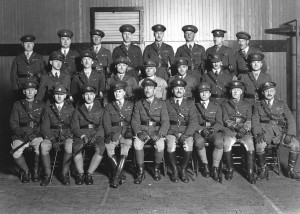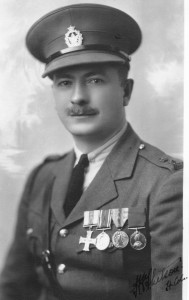Officer pose after the Trooping of the colours parade, April 1925

The Inter-War Years
Between the Wars
Perhaps the greatest problem facing the Army after the war was how to reorganize and perpetuate 216 reinforcing and 50 fighting battalions of the CEF within the framework of the “Old Militia” regiments which remained behind in Canada. In British Columbia, National Defence Headquarters decided to create a British Columbia Regiment with six battalions. The DCOR and 7th Battalion would be joined to form the First Battalion (7th Battalion CEF), 1st BC Regiment (DCO). The 29th and Vancouver Regiments would form the second Battalion and the 47th Battalion CEF and the Westminster Regiment the 3rd Battalion. The 11th Irish Fusiliers were reformed as the Irish Fusiliers of Canada.
The Drill Hall was a busy place with the Vancouver Regiment parading Mondays and Wednesdays, the Seaforth Highlanders on Tuesdays and Thursdays, and the BC Regiment the other days.
In May 1924 the Westminster and Vancouver Regiments went their separate ways after the large BC Regiment was broken up. Later that year, the Regiment’s affiliation with the Rifle Brigade was reaffirmed. However, the Regiment was still classified as an Infantry Regiment and carried Colours on parade. The Regiment was commanded by Lieutenant- Colonel William Foster, CMG, DSO, VD, from 1924 – 1927; he also served as the Chief of the Vancouver Police.
In 1927 the Regiment received a new commanding officer. Lieutenant-Colonel HFG Letson, MC, took over command of the Regiment in 1927 and during his years rifle traditions were strengthened. In 1928, Officers were authorized to wear black ties on parade. In January, 1930, the Regiment reverted to Rifles and the Colours were laid up in Christ Church Cathedral, where they hang over the Alter today. The Regiment’s name was changed to The British Columbia Regiment (Duke of Connaught’s Own Rifles) and trooping was discontinued; Rifle drill was adopted once again. A new cap badge was designed by Colonel Letson, which incorporated the Badge of the 7th with Rifle symbols, a Ducal Coronet, a wreath, and a scroll with “The Duke of Connaught’s Own Rifles” on it. The initial version had ten battle honours from the First World War, and the Battle Honour “South Africa” was added in 1933. The cap badge has remained unchanged since this time.
In the 1930s the Militia in Canada was badly equipped and under funded, making do with First World War uniforms, weapons and equipment. In spite of appeals from the press this situation did not improve until the war started two years later. One bright light to emerge in 1936 was another top class rifleman, Corporal PM Gibault, who won many trophies at the BCRA shoot, and later that year shot at Ottawa on the BC Team. He won the MacDougall Challenge Cup and Miniature in competition with more than 450 other shooters from England, Australia, and Canada; he also won the Gooding Gold Medal for the best marksman under 21 years of age.
As the world became concerned about the rise of fascist powers in Europe in the late 1930s, resources were improved and the Militia started to receive samples of new weapons and equipment that would soon come into side spread use. The strength of the Canadian Army as it approached the Second World War, as ever, was the quality of its soldiers and leaders. Canada faced the likelihood of another war with significantly less enthusiasm than a generation earlier; however, the grim determination to once again make sacrifices for Canada and democracy and emerge as Victors was a powerful as ever.


